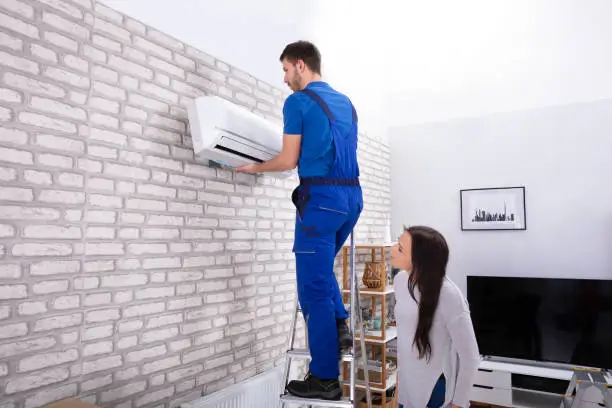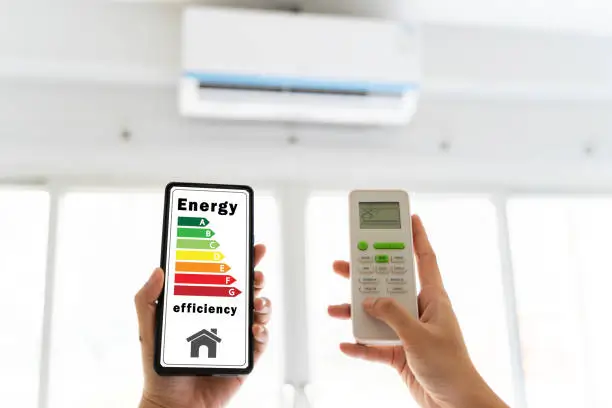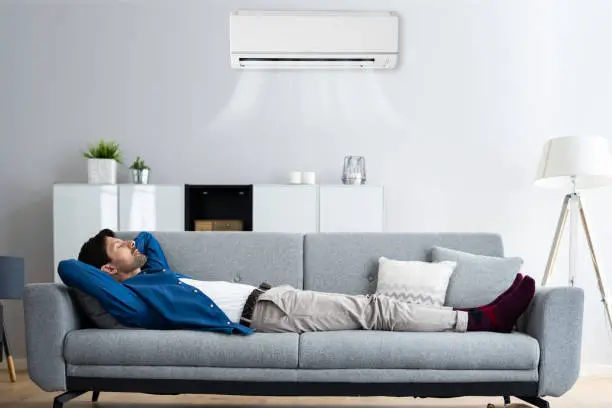When you live in Australia, a sweltering hot summer is inevitable. Many of us switch on the air conditioner to cool down, but with this comes a higher electricity bill – something most people would like to avoid. But what if there was a way to stay comfortable without breaking the bank? The secret lies in finding the most efficient aircon in Australia. By investing in an energy-efficient model, you can not only save on your utility costs but also contribute to a more sustainable future.
Energy-efficient air conditioners are designed to run at a lower cost and reduce the output of greenhouse gas emissions and other pollutants. Split system units are typically the most energy efficient air conditioners you can buy, with brands like Daikin and Hisense offering a range of high-efficiency models. While window air conditioners are less energy-efficient than split systems, they can be an effective option where ducted or split systems are not feasible. Take, for instance, Rinnai’s J Series – a super-efficient air conditioner with a remarkable 9-star energy rating.
But how do you choose the right energy-efficient air conditioner for your home? What factors should you consider to ensure you’re getting the most value for your money? This comprehensive guide will explore the world of eco-friendly air conditioning solutions, helping you navigate the options and make an informed decision that suits your needs and your budget.
Understanding Energy-Efficient Air Conditioners
In Australia, air conditioners must meet Minimum Energy Performance Standards (MEPS) and are assigned star rating labels based on their efficiency compared to the Australian standard. The more stars an air conditioner has, the more energy-efficient it is, resulting in lower running costs for the homeowner. The recently introduced Zoned Energy Rating Label (ZERL) takes this a step further, providing three separate cooling and heating star ratings for different climate zones across the country. This helps consumers select the most suitable and efficient air conditioner for their local climate, ensuring optimal performance and cost savings.
What are Energy Ratings?
Energy ratings are a crucial consideration when choosing an energy-efficient air conditioner in Australia. These ratings provide a clear indication of the appliance’s energy efficiency, with higher-rated models typically offering greater cost savings on electricity bills. The energy efficiency star rating system evaluates air conditioners against Australian standards, with the most efficient models earning five or six stars (or more).
Benefits of Energy-Efficient Air Conditioners
Investing in an energy-efficient air conditioner can provide numerous benefits for Australian households. These include lower running costs, reduced greenhouse gas emissions, and improved indoor air quality through features like air purification. With heating and cooling accounting for around 40% of household energy use, upgrading to an energy-efficient model can result in significant savings on energy bills. Additionally, the environmental impact is reduced, contributing to a more sustainable future.
Types of Energy-Efficient Air Conditioners
When it comes to energy-efficient air conditioners in Australia, there are several popular options to consider. Split system air conditioners, ducted air conditioners, and window air conditioners each offer their own unique benefits and considerations for homeowners seeking to optimise energy efficiency and cost savings.
Split System Air Conditioners
Split system air conditioners are one of the most energy-efficient appliances for cooling and heating Australian homes. These systems consist of an indoor unit and an outdoor unit, allowing for discreet and quiet operation. The efficiency of split system air conditioners is determined by how much cooling or heating they provide compared to their electricity usage, with higher-rated models providing greater cost savings on energy bills.
Ducted Air Conditioners
Ducted air conditioners are an ideal choice for larger homes and commercial spaces, providing centralised cooling and heating through a network of ducts throughout the building. While not as energy-efficient as split system models, ducted air conditioners can still offer impressive performance when equipped with features like inverter technology and advanced airflow design.
Window Air Conditioners
For smaller rooms or spaces where other air conditioning systems are not feasible, window air conditioners can be a cost-effective option. While not as energy-efficient as split or ducted systems, modern window air conditioners are incorporating innovative technologies like inverter compressors to improve their energy performance and reduce running costs.
Top Brands for Most Efficient Aircon Australia
When it comes to finding the most energy-efficient air conditioners in Australia, two leading brands stand out: Daikin and Hisense. Both manufacturers offer a range of split system models that boast impressive energy efficiency ratings and advanced features.
Daikin Energy-Efficient Air Conditioners
Daikin is a renowned leader in the air conditioning industry, renowned for its high energy efficiency ratings, advanced features, and whisper-quiet operation. The Daikin 2.5kW Cora Air Conditioner, for example, has a 6-star energy rating and retails for approximately $1,000. This split system model offers quiet operation, humidity control, and smart home connectivity, making it a popular choice for energy-conscious Australian households.
Hisense Energy-Efficient Air Conditioners
Hisense is another major player in the Australian energy-efficient air conditioner market. The Hisense 2.5kW V Series Reverse Cycle Air Conditioner boasts an impressive 8.5-star energy rating and costs about $1,000. Hisense’s air conditioners combine DC inverter technology, advanced airflow design, and air purification features to deliver high energy efficiency while maintaining optimal comfort levels.
Factors to Consider When Choosing an Efficient Aircon
When selecting an energy-efficient air conditioner for your Australian home, it’s crucial to consider several key factors to ensure you get the most cost-effective and environmentally friendly solution. Among the most important considerations are the cooling and heating capacity, energy efficiency star ratings, and the size and layout of the room or space you need to climate control.
Cooling and Heating Capacity
The air conditioner’s cooling and heating capacity, measured in kilowatts (kW), should be appropriately sized for the room or home you need to climate control. An air conditioner that is too small will have to work harder to cool or heat the space, leading to higher energy consumption and reduced efficiency. Conversely, an air conditioner that is too large will use more energy than necessary, wasting power and money. Matching the air conditioner’s capacity to the size of the room is essential for achieving optimal energy efficiency.
Energy Star Ratings
The energy efficiency star rating is a critical factor when choosing an eco-friendly air conditioner. Air conditioners in Australia are required to meet minimum energy performance standards (MEPS) and are assigned star ratings based on their tested efficiency. The more stars, the more energy-efficient the model, and the lower the ongoing running costs will be. Newer air conditioners also come with the Zoned Energy Rating Label (ZERL), which provides efficiency ratings for different climate zones, further helping consumers select the best option for their local conditions.
Room Size and Layout
The size and layout of the room or home you need to climate control will also impact the optimal air conditioner configuration. Factors like ceiling height, window placements, and the presence of other heat sources all influence which type of air conditioning system – split system, ducted, or window unit – will be the most energy-efficient solution. Consulting with a professional installer can help ensure you choose the right-sized and configured air conditioner for your specific space and requirements.
Efficient Air Conditioner Features to Look For
When shopping for an energy-efficient air conditioner in Australia, certain features can make a significant difference in your unit’s performance and running costs. Two key features to prioritise are inverter technology and smart controls with Wi-Fi connectivity.
Inverter Technology
Inverter technology, commonly found in leading air conditioner brands like Daikin and Hisense, is a game-changer when it comes to efficient aircon features. This innovative approach automatically regulates the cooling and heating output to precisely match the room’s needs, reducing energy consumption compared to traditional non-inverter models. By maintaining the desired temperature more efficiently, inverter technology aircon efficiency can translate to substantial savings on your energy bills.
Smart Controls and Wi-Fi Connectivity
The integration of smart controls and Wi-Fi connectivity in modern air conditioners adds another layer of efficiency. These features allow users to remotely monitor and adjust the air conditioner, ensuring it only runs when needed and avoiding wasteful operation. Features like human presence sensors and demand response capabilities can further enhance the efficiency of these smart controls wifi aircon systems, providing a more tailored and energy-conscious cooling and heating experience.
Cost Savings with Most Efficient Aircon Australia
While energy-efficient air conditioners may have a higher upfront cost, the long-term savings on electricity bills can make them a worthwhile investment. According to the Queensland Government, switching from a 3-star to a 4-star air conditioner can save you an average of $134 per year on your energy bills. Some state and territory governments in Australia also offer rebates and incentives to encourage the purchase of high-efficiency air conditioning systems, further reducing the overall cost savings efficient aircon australia.
Upfront vs. Long-Term Costs
Consumers should weigh the initial outlay against the projected upfront vs long term aircon costs to determine the best option for their budget and household needs. Energy-efficient air conditioners with higher upfront prices often deliver significant long-term savings through reduced energy consumption and maintenance expenses.
Rebates and Incentives
To further encourage the adoption of aircon rebates and incentives australia, various state and territory governments in Australia offer rebates and incentives for the purchase of high-efficiency air conditioning systems. These programs can help offset the initial cost, making energy-efficient air conditioners more accessible to Australian households.
Installation and Maintenance Tips
Proper Installation for Efficiency
Proper aircon installation is essential for maximising energy efficiency. A professional installer will ensure the unit is the right size for the space and that it is positioned and configured correctly to deliver optimal performance. Correct sizing, placement, and setup can make a significant difference in the air conditioner’s ability to operate efficiently and keep your home comfortable.
Regular Maintenance and Cleaning
Regular maintenance and cleaning are also crucial for maintaining the efficiency of your aircon system. Tasks like replacing air filters and keeping the outdoor unit clear of debris can help the system run at its best. Following the manufacturer’s guidelines for maintenance and care will help ensure your air conditioner continues to operate efficiently over its lifespan. Split system heaters and coolers should be serviced by a professional every 2-3 years, while cool-only models may only need yearly servicing.
By prioritising proper aircon installation and adhering to a regular maintenance schedule, you can ensure your system runs at peak efficiency, minimising breakdowns and reducing your overall running costs. Additionally, features like self-cleaning functions on some models can further simplify the maintenance process and keep your aircon operating at its best.
Eco-Friendly Air Conditioning Solutions
In addition to boasting high energy-efficiency ratings, modern air conditioners are also incorporating more eco-friendly features to reduce their environmental impact. One key consideration is the type of refrigerant used, with newer, low-global-warming-potential refrigerants like R32 becoming increasingly common in eco-friendly aircon solutions australia.
Refrigerant Types
The refrigerant used in an air conditioner can have a significant impact on its environmental footprint. Traditional refrigerants like R22 have been phased out due to their high global warming potential, and many brands now opt for more sustainable refrigerant types like R32 that are better for the environment.
Energy-Saving Modes
To further enhance eco-friendliness, many energy-efficient air conditioners feature advanced energy-saving modes that automatically adjust the cooling or heating output to match the room’s needs, reducing unnecessary energy use and minimising the carbon footprint. These smart features allow Australian households to stay comfortable while minimising their environmental impact.
Case Studies: Efficient Aircon in Australian Homes
To illustrate the real-world benefits of energy-efficient air conditioning, we’ve gathered case studies of Australian households that have upgraded to high-efficiency models. These examples highlight the significant cost savings, reduced energy usage, and improved indoor comfort these homeowners have experienced.
In one case, the Smith family in Melbourne replaced their aging ducted system with a Daikin 6-star energy-rated split system air conditioner. They saw their annual cooling and heating costs drop by over $300, while also enjoying enhanced comfort and air quality in their home. “The new air conditioner is so much quieter and more efficient than our old one,” said Mrs. Smith. “We’re thrilled with the energy savings and the difference it’s made to our living space.”
Another example is the Jones household in Brisbane, who swapped out their window unit for a Hisense 8.5-star rated reverse cycle split system. “The difference in our energy bills has been remarkable,” commented Mr. Jones. “We’re now paying around $150 less per quarter, and the air conditioning keeps our home comfortable all year round without straining the budget.”
These real-life case studies demonstrate how adopting energy-efficient air conditioning solutions can deliver tangible financial and environmental benefits for Australian homeowners. By sharing these examples, we hope to inspire more households to consider upgrading to the most efficient aircon options available in the market today.
Conclusion
In conclusion, choosing the most efficient air conditioner for your Australian home is an important decision that can lead to significant cost savings and environmental benefits. By understanding the different types of energy-efficient air conditioners, evaluating key factors like cooling capacity and energy star ratings, and considering advanced features like inverter technology and smart controls, consumers can find the best solution to meet their needs. With the right energy-efficient air conditioner, Aussie households can stay comfortable year-round while reducing their carbon footprint and utility expenses.
The Australian market offers a range of energy-efficient air conditioning options, from split system units by Mitsubishi Electric and Daikin ducted systems to energy-efficient window models from LG. By selecting an air conditioner with an EER of at least 3.5, Australians can enjoy optimal energy efficiency and cost savings. Additionally, factors like climate, noise levels, and installation considerations should be taken into account to ensure the selected air conditioner is the most suitable for the home.
Ultimately, the pursuit of the most efficient aircon in Australia is a journey towards greater sustainability and cost-effectiveness. By making informed decisions and prioritising energy-efficient features, Aussie households can not only stay comfortable but also contribute to a greener future. With the right guidance and available options, the path to finding the most efficient air conditioner for your home has never been clearer.








